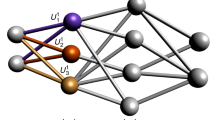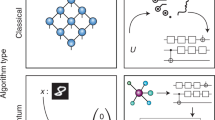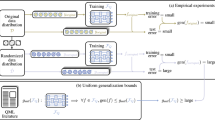Abstract
It is unknown whether near-term quantum computers are advantageous for machine learning tasks. In this work we address this question by trying to understand how powerful and trainable quantum machine learning models are in relation to popular classical neural networks. We propose the effective dimension—a measure that captures these qualities—and prove that it can be used to assess any statistical model’s ability to generalize on new data. Crucially, the effective dimension is a data-dependent measure that depends on the Fisher information, which allows us to gauge the ability of a model to train. We demonstrate numerically that a class of quantum neural networks is able to achieve a considerably better effective dimension than comparable feedforward networks and train faster, suggesting an advantage for quantum machine learning, which we verify on real quantum hardware.
This is a preview of subscription content, access via your institution
Access options
Access Nature and 54 other Nature Portfolio journals
Get Nature+, our best-value online-access subscription
$29.99 / 30 days
cancel any time
Subscribe to this journal
Receive 12 digital issues and online access to articles
$99.00 per year
only $8.25 per issue
Buy this article
- Purchase on Springer Link
- Instant access to full article PDF
Prices may be subject to local taxes which are calculated during checkout



Similar content being viewed by others
Data availability
The data for the graphs and analyses in this study was generated using Python. Source data are provided with this paper. All other data can be accessed via the following Zenodo repository: https://doi.org/10.5281/zenodo.4732830 (ref. 56).
Code availability
All code to generate the data, figures and analyses in this study is publicly available with detailed information on the implementation via the following Zenodo repository: https://doi.org/10.5281/zenodo.4732830 (ref. 56).
References
Goodfellow, I., Bengio, Y. & Courville, A. Deep Learning (MIT Press, 2016); http://www.deeplearningbook.org
Baldi, P. & Vershynin, R. The capacity of feedforward neural networks. Neural Networks 116, 288–311 (2019).
Dziugaite, G. K. & Roy, D. M. Computing nonvacuous generalization bounds for deep (stochastic) neural networks with many more parameters than training data. In Proc. 33rd Conference on Uncertainty in Artificial Intelligence (UAI, 2017).
Schuld, M. Supervised Learning with Quantum Computers (Springer, 2018).
Zoufal, C., Lucchi, A. & Woerner, S. Quantum generative adversarial networks for learning and loading random distributions. npj Quant. Inf. 5, 1–9 (2019).
Romero, J., Olson, J. P. & Aspuru-Guzik, A. Quantum autoencoders for efficient compression of quantum data. Quant. Sci. Technol. 2, 045001 (2017).
Dunjko, V. & Briegel, H. J. Machine learning & artificial intelligence in the quantum domain: a review of recent progress. Rep. Prog. Phys. 81, 074001 (2018).
Ciliberto, C. et al. Quantum machine learning: a classical perspective. Proc. Roy. Soc. A 474, 20170551 (2018).
Killoran, N. et al. Continuous-variable quantum neural networks. Phys. Rev. Res. 1, 033063 (2019).
Schuld, M., Sinayskiy, I. & Petruccione, F. The quest for a quantum neural network. Quant. Inf. Proc. 13, 2567–2586 (2014).
Farhi, E. & Neven, H. Classification with quantum neural networks on near term processors. Quant. Rev. Lett. 1, 2 (2020).
Aaronson, S. Read the fine print. Nat. Phys. 11, 291–293 (2015).
Vapnik, V. The Nature of Statistical Learning Theory Vol. 8, 1–15 (Springer, 2000).
Vapnik, V. N. & Chervonenkis, A. Y. On the uniform convergence of relative frequencies of events to their probabilities. Theory Probab. Appl. 16, 264–280 (1971).
Sontag, E. D Neural Networks and Machine Learning 69–95 (Springer, 1998).
Vapnik, V., Levin, E. & Cun, Y. L. Measuring the VC-dimension of a learning machine. Neural Comput. 6, 851–876 (1994).
Neyshabur, B., Bhojanapalli, S., McAllester, D. & Srebro, N. Exploring generalization in deep learning. In Advances in Neural Information Processing Systems 30, 5947–5956 (NIPS, 2017).
Arora, S., Ge, R., Neyshabur, B. & Zhang, Y. Stronger generalization bounds for deep nets via a compression approach. In Proc. 35th International Conference on Machine Learning Vol. 80, 254–263 (PMLR, 2018); http://proceedings.mlr.press/v80/arora18b.html
Wright, L. G. & McMahon, P. L. The capacity of quantum neural networks. In Conference on Lasers and Electro-Optics JM4G.5 (Optical Society of America, 2020); http://www.osapublishing.org/abstract.cfm?URI=CLEO_QELS-2020-JM4G.5
Du, Y., Hsieh, M.-H., Liu, T. & Tao, D. Expressive power of parametrized quantum circuits. Phys. Rev. Res. 2, 033125 (2020).
Huang, H.-Y. et al. Power of data in quantum machine learning. Nat. Commun. 12, 2631 (2021).
Berezniuk, O., Figalli, A., Ghigliazza, R. & Musaelian, K. A scale-dependent notion of effective dimension. Preprint at https://arxiv.org/abs/2001.10872 (2020).
Rissanen, J. J. Fisher information and stochastic complexity. IEEE Trans. Inf. Theory 42, 40–47 (1996).
Cover, T. M. & Thomas, J. A. Elements of Information Theory (Wiley, 2006).
Nakaji, K. & Yamamoto, N. Expressibility of the alternating layered ansatz for quantum computation. Quantum 5, 434 (2021).
Holmes, Z., Sharma, K., Cerezo, M. & Coles, P. J. Connecting ansatz expressibility to gradient magnitudes and barren plateaus. Preprint at https://arxiv.org/abs/2101.02138 (2021).
McClean, J. R., Boixo, S., Smelyanskiy, V. N., Babbush, R. & Neven, H. Barren plateaus in quantum neural network training landscapes. Nat. Commun. 9, 1–6 (2018).
Wang, S. et al. Noise-induced barren plateaus in variational quantum algorithms. Preprint at https://arxiv.org/abs/2007.14384 (2020).
Cerezo, M., Sone, A., Volkoff, T., Cincio, L. & Coles, P. J. Cost function dependent barren plateaus in shallow parametrized quantum circuits. Nat. Commun. 12, 1791 (2021).
Verdon, G. et al. Learning to learn with quantum neural networks via classical neural networks. Preprint at https://arxiv.org/abs/1907.05415 (2019).
Volkoff, T. & Coles, P. J. Large gradients via correlation in random parameterized quantum circuits. Quant. Sci. Technol. 6, 025008 (2021).
Skolik, A., McClean, J. R., Mohseni, M., van der Smagt, P. & Leib, M. Layerwise learning for quantum neural networks. Quant. Mach. Intell. 3, 5 (2021).
Huembeli, P. & Dauphin, A. Characterizing the loss landscape of variational quantum circuits. Quant. Sci. Technol. 6, 025011 (2021).
Bishop, C. Exact calculation of the Hessian matrix for the multilayer perceptron. Neural Comput. 4, 494–501 (1992).
LeCun, Y. A., Bottou, L., Orr, G. B. & Müller, K.-R. Efficient BackProp 9–48 (Springer, 2012); https://doi.org/10.1007/978-3-642-35289-8_3
Cerezo, M. & Coles, P. J. Higher order derivatives of quantum neural networks with barren plateaus. Quant. Sci. Technol. 6, 035006 (2021).
Kunstner, F., Hennig, P. & Balles, L. Limitations of the empirical Fisher approximation for natural gradient descent. In Advances in Neural Information Processing Systems 32 4156–4167 (NIPS, 2019); http://papers.nips.cc/paper/limitations-of-fisher-approximation
Karakida, R., Akaho, S. & Amari, S.-I. Universal statistics of Fisher information in deep neural networks: mean field approach. In Proc. Machine Learning Research Vol. 89, 1032–1041 (PMLR, 2019); http://proceedings.mlr.press/v89/karakida19a.html
Schuld, M., Bocharov, A., Svore, K. M. & Wiebe, N. Circuit-centric quantum classifiers. Phys. Rev. A 101, 032308 (2020).
Schuld, M., Sweke, R. & Meyer, J. J. Effect of data encoding on the expressive power of variational quantum-machine-learning models. Phys. Rev. A 103, 032430 (2021).
Lloyd, S., Schuld, M., Ijaz, A., Izaac, J. & Killoran, N. Quantum embeddings for machine learning. Preprint at https://arxiv.org/abs/2001.03622 (2020).
Cong, I., Choi, S. & Lukin, M. D. Quantum convolutional neural networks. Nat. Phys. 15, 1273–1278 (2019).
Amari, S.-I. Natural gradient works efficiently in learning. Neural Comput. 10, 251–276 (1998).
Liang, T., Poggio, T., Rakhlin, A. & Stokes, J. Fisher–Rao metric, geometry, and complexity of neural networks. In Proc. Machine Learning Research Vol. 89, 888–896 (PMLR, 2019); http://proceedings.mlr.press/v89/liang19a.html
Neyshabur, B., Salakhutdinov, R. R. & Srebro, N. Path-SGD: path-normalized optimization in deep neural networks. In Advances in Neural Information Processing Systems 28, 2422–2430 (NIPS, 2015).
Neyshabur, B., Tomioka, R. & Srebro, N. Norm-based capacity control in neural networks. In Proc. Machine Learning Research Vol. 40, 1376–1401 (PMLR, 2015); http://proceedings.mlr.press/v40/Neyshabur15.html
Bartlett, P. L., Foster, D. J. & Telgarsky, M. J. Spectrally-normalized margin bounds for neural networks. In Advances in Neural Information Processing Systems 30, 6240–6249 (NIPS, 2017); http://papers.nips.cc/paper/7204-spectrally-normalized
Rissanen, J. J. Fisher information and stochastic complexity. IEEE Trans. Inf. Theory 42, 40–47 (1996).
Marrero, C. O., Kieferová, M. & Wiebe, N. Entanglement induced barren plateaus. Preprint at https://arxiv.org/abs/2010.15968 (2020).
Havlíček, V. et al. Supervised learning with quantum-enhanced feature spaces. Nature 567, 209–212 (2019).
Sim, S., Johnson, P. D. & Aspuru-Guzik, A. Expressibility and entangling capability of parameterized quantum circuits for hybrid quantum-classical algorithms. Adv. Quant. Technol. 2, 1900070 (2019).
Jia, Z. & Su, H. Information-theoretic local minima characterization and regularization. In Proc. 37th International Conference on Machine Learning Vol. 119, 4773–4783 (PMLR, 2020); http://proceedings.mlr.press/v119/jia20a.html
Virmaux, A. & Scaman, K. Lipschitz regularity of deep neural networks: analysis and efficient estimation. In Advances in Neural Information Processing Systems 31, 3835–3844 (NIPS, 2018); http://papers.nips.cc/paper/lipschitz-regularity-of-deep-neural-networks
Sweke, R. et al. Stochastic gradient descent for hybrid quantum-classical optimization. Quantum 4, 314 (2020).
Dua, D. & Graff, C. UCI Machine Learning Repository (2017); http://archive.ics.uci.edu/ml
Abbas, A. et al. amyami187/effective_dimension: The Effective Dimension Code (Zenodo, 2021); https://doi.org/10.5281/zenodo.4732830
Acknowledgements
We thank M. Schuld for insightful discussions on data embedding in quantum models. We also thank T. L. Scholten for constructive feedback on the manuscript. C.Z. acknowledges support from the National Centre of Competence in Research Quantum Science and Technology (QSIT).
Author information
Authors and Affiliations
Contributions
The main ideas were developed by all of the authors. A.A. provided numerical simulations. D.S. and A.F. proved the technical claims. All authors contributed to the write-up.
Corresponding author
Ethics declarations
Competing interests
The authors declare no competing interests.
Additional information
Peer review information Nature Computational Science thanks Patrick Coles and the other, anonymous, reviewer(s) for their contribution to the peer review of this work. Handling editor: Jie Pan, in collaboration with the Nature Computational Science team.
Publisher’s note Springer Nature remains neutral with regard to jurisdictional claims in published maps and institutional affiliations.
Supplementary information
Supplementary Information
Supplementary Figs. 1–11, Sections 1–5 and Table 1.
Source data
Source Data Fig. 2
Unprocessed raw text data are stored in text files, containing the numerical values used to generate the eigenvalue distributions for each model in the subplots of Fig. 2.
Source Data Fig. 3
In the zip folder there are text data files containing the numerical values for the effective dimension for each model and labeled accordingly, there is also a file containing the values of the axis. Then, the the raw numerical data for the loss values, their averages and the standard deviation around the average loss values are stored in text files for each model and labeled transparently.
Rights and permissions
About this article
Cite this article
Abbas, A., Sutter, D., Zoufal, C. et al. The power of quantum neural networks. Nat Comput Sci 1, 403–409 (2021). https://doi.org/10.1038/s43588-021-00084-1
Received:
Accepted:
Published:
Issue Date:
DOI: https://doi.org/10.1038/s43588-021-00084-1
This article is cited by
-
Understanding quantum machine learning also requires rethinking generalization
Nature Communications (2024)
-
Practical application of quantum neural network to materials informatics
Scientific Reports (2024)
-
Theoretical guarantees for permutation-equivariant quantum neural networks
npj Quantum Information (2024)
-
Quantum-parallel vectorized data encodings and computations on trapped-ion and transmon QPUs
Scientific Reports (2024)
-
Advancements in Quantum Computing—Viewpoint: Building Adoption and Competency in Industry
Datenbank-Spektrum (2024)



